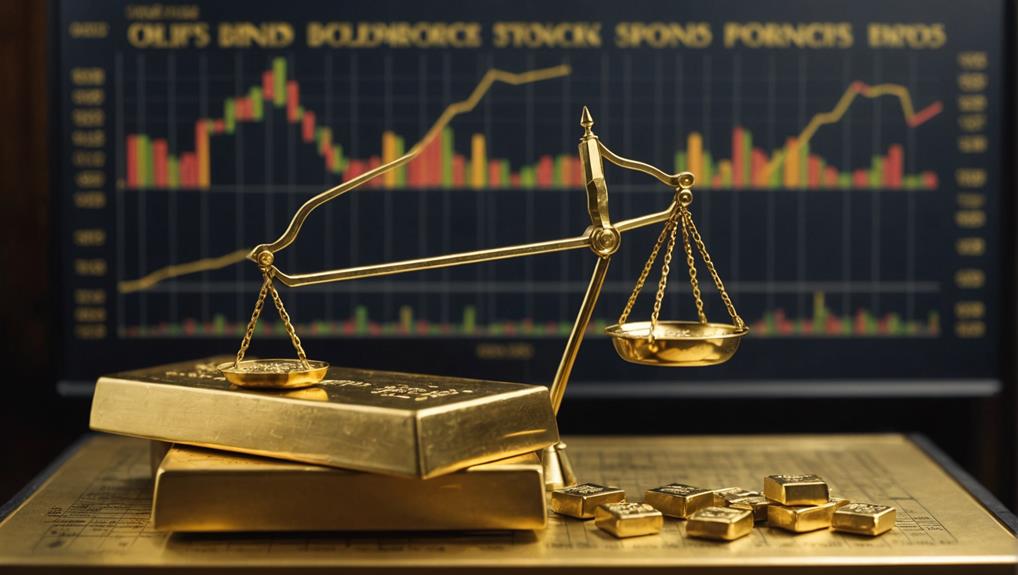Investing in Gold: Lessons From History
Gold has maintained its significance as a crucial asset throughout history, especially in times of economic instability. Its role as a safe haven is evident in its consistent inverse relationship with fiat currencies and its ability to withstand financial crises.
Major historical events, such as the collapse of the Bretton Woods system, have had a profound impact on gold prices, highlighting its importance in ensuring global economic stability. Understanding these historical dynamics is essential for grasping why gold continues to be a fundamental element in a well-rounded investment portfolio.
How have these historical patterns influenced present-day investment approaches, and what insights can contemporary investors glean from them?
Key Insights
- Gold's enduring value is evident from its historical role as a medium of exchange and store of wealth.
- Gold often appreciates during financial crises, serving as a safe haven asset.
- The discontinuation of the Bretton Woods Agreement in 1971 highlights the impact of monetary policy changes on gold prices.
- Gold's inverse relationship with the US dollar demonstrates its utility in portfolio diversification.
- Central banks' gold reserves significantly influence market dynamics and gold demand.
Historical Role of Gold

Gold has played a pivotal role throughout history as a medium of exchange and a reliable store of wealth, owing to its unique properties and inherent value. In ancient times, gold coins facilitated trade, while goldsmiths served as custodians of wealth.
The adoption of the gold standard, where currencies were backed by gold reserves, promoted economic stability until its abandonment in the 1970s. The labor-intensive process of gold mining, reflecting the metal's scarcity, has contributed to its enduring value.
Consequently, gold has been viewed as a safeguard against inflation, preserving purchasing power during times of economic turmoil. Across civilizations, the consistent recognition of gold's worth underscores its enduring significance. Its prominent role in financial systems solidifies its reputation as a dependable asset.
Major Events Influencing Gold Prices
Major global events have historically played a significant role in shaping gold prices, emphasizing its status as a safe-haven asset during times of economic and geopolitical uncertainty. The 2008 Financial Crisis, for instance, triggered a remarkable 101.1% surge in gold value from 2008 to 2012, highlighting its resilience amidst market upheavals.
Geopolitical tensions also tend to drive gold prices higher as investors flock to its perceived stability.
Gold prices can be influenced by various key events, such as:
- Market interventions: Instances of gold price manipulation can distort its true value.
- Central banks' gold reserves: Fluctuations in these reserves can impact market dynamics.
- Historical gold standard: The legacy of the gold standard in the United States continues to shape perspectives on the precious metal.
- Ancient Egypt's use of gold: Early civilizations' reliance on gold underscores its enduring value over centuries.
The consistent performance of gold during times of instability underscores its enduring allure as a reliable asset.
The Gold Standard and Bretton Woods

The Gold Standard, a monetary system where currencies were tied to a specific amount of gold, had a profound impact on global economic policies until the mid-20th century. Central banks kept gold reserves to support their currency issuance, offering stability while restricting monetary flexibility.
In 1944, the Bretton Woods Agreement introduced a new system pegging the US dollar to gold, with other currencies linked to the dollar. This arrangement aimed to stabilize the global economy after World War II but faltered in 1971 when the US discontinued dollar convertibility to gold.
These pivotal shifts have significantly influenced contemporary perspectives on gold's role in the global economy and its implications for investment strategies.
Factors Driving Gold Demand and Supply
Understanding the intricate interplay between gold demand and supply is crucial for investors navigating the precious metals market. Gold demand is shaped by various factors, such as jewelry, investment, and central bank purchases, with the latter notably on the rise to bolster prices.
On the supply side, factors like mine production, recycling, and central bank sales all contribute to the overall availability of gold. Additionally, technological and dental applications also impact gold consumption trends.
Key elements influencing gold dynamics encompass central bank purchases, gold production statistics, gold mining techniques, and gold smuggling. These factors collectively influence the market dynamics and pricing of gold.
Furthermore, the presence of gold storage facilities plays a pivotal role in facilitating the secure handling of this valuable metal, thereby influencing global gold trade and investment strategies.
Gold's Performance Vs. Stocks and Bonds

Gold has consistently outperformed stocks and bonds over the long term, boasting an average annual return of approximately 10% since 1971. This robust performance is underpinned by historical evidence showcasing gold's effectiveness in preserving wealth during economic downturns and periods of inflation.
Serving as a reliable safe-haven asset, gold acts as a hedge against market volatility, making it a valuable addition to investment portfolios. Its low correlation with traditional assets like stocks and bonds enhances its appeal as a diversification tool, ultimately reducing overall portfolio risk.
The comparative performance of gold, stocks, and bonds can be summarized as follows:
- Gold: Average Annual Return of 10%, Low Correlation with Stocks
- Stocks: Average Annual Return of 7-8%, High Correlation with Stocks
- Bonds: Average Annual Return of 5-6%, Moderate Correlation with Stocks
These characteristics emphasize gold's significance in wealth preservation and risk mitigation in investment strategies.
Methods of Investing in Gold
Investors can approach gold investment through several methods, each with its own set of advantages and considerations.
Purchasing physical gold in the form of coins or bars represents a tangible asset, while gold ETFs offer a more liquid and convenient option for tracking gold prices.
Moreover, investing in gold mining stocks provides exposure to the gold market's dynamics and potential for higher returns.
Physical Gold Forms
Investing in physical gold offers a tangible way to diversify one's portfolio, with options like gold bars, coins, and jewelry each presenting unique benefits. Gold bars, typically manufactured by private mints, vary in weight and are a popular choice for those seeking a straightforward means of owning and safeguarding wealth.
Gold coins, whether historical treasures from empires like Rome and Byzantium or modern pieces like the gold sovereign, hold both intrinsic and collector's worth. Gold jewelry, prized for its ornamental value, can also serve as an investment, though its appraisal includes considerations of craftsmanship.
Altogether, gold bullion, comprising bars and coins, allows investors direct possession of this precious metal.
Gold ETFs Insights
Gold ETFs offer a modern way for investors to access gold price movements without the complexities of owning physical gold. These exchange-traded funds, similar to stocks, provide liquidity and easy trading on stock exchanges throughout the day. Unlike gold certificates that merely represent ownership of gold held elsewhere, Gold ETFs are backed by physical gold holdings typically stored in secure locations such as Switzerland. This approach helps mitigate risks related to gold confiscation and the challenges of gold storage. By mirroring the performance of gold prices, Gold ETFs present a cost-effective and convenient option compared to holding gold as a currency or investing in gold-backed currencies.
| Feature | Gold ETFs |
|---|---|
| Storage Location | Switzerland |
| Trading Process | Stock Exchanges |
| Backing | Physical Gold Holdings |
Mining Stocks Overview
Gold mining stocks offer investors an alternative way to gain exposure to the gold industry without owning physical gold. Investing in these stocks can provide leverage to gold prices through operational efficiencies and exploration success, potentially leading to higher returns.
In addition to capital appreciation potential, some gold mining companies also offer dividends, providing investors with a regular income stream.
One key advantage of investing in gold mining stocks is the potential for capital appreciation. Successful exploration efforts and efficient operations can result in significant increases in stock prices. However, it is important to consider geopolitical risks that can impact gold mining operations and subsequently affect stock performance.
Additionally, companies that effectively manage production costs can offer better returns to investors. Conducting thorough research on management, production costs, and exploration projects is essential for making well-informed investment decisions in the gold mining sector.
Conclusion
To conclude, historical evidence underscores gold's enduring status as a safe haven asset and a hedge against currency devaluation. Key historical events such as the Gold Standard and the Bretton Woods system have significantly influenced gold prices over time.
Understanding the factors driving gold's demand and supply, as well as its performance relative to stocks and bonds, underscores the importance of including gold in a well-diversified investment portfolio. By leveraging these historical insights, investors can make informed decisions with confidence.
The Gold Information Network
11900 Biscayne Blvd, Ste 127B, Miami, FL 33181
(305) 449-9094
https://goldinfo.net
source https://rondewitt.com/gold-investing-lessons-history/
Comments
Post a Comment